How to be a successful affiliate marketer: Growth strategies & tips
By Phil Norris March 28, 2024
Did you know the average affiliate marketer makes just over $8,000 a month?
Not bad for a job that lets you work anywhere, set your own hours, and earn passive income.
But, as always, there’s a catch:
That figure is massively skewed by affiliate marketers with 10+ years of experience, who bring in an average monthly income of $44,000+.
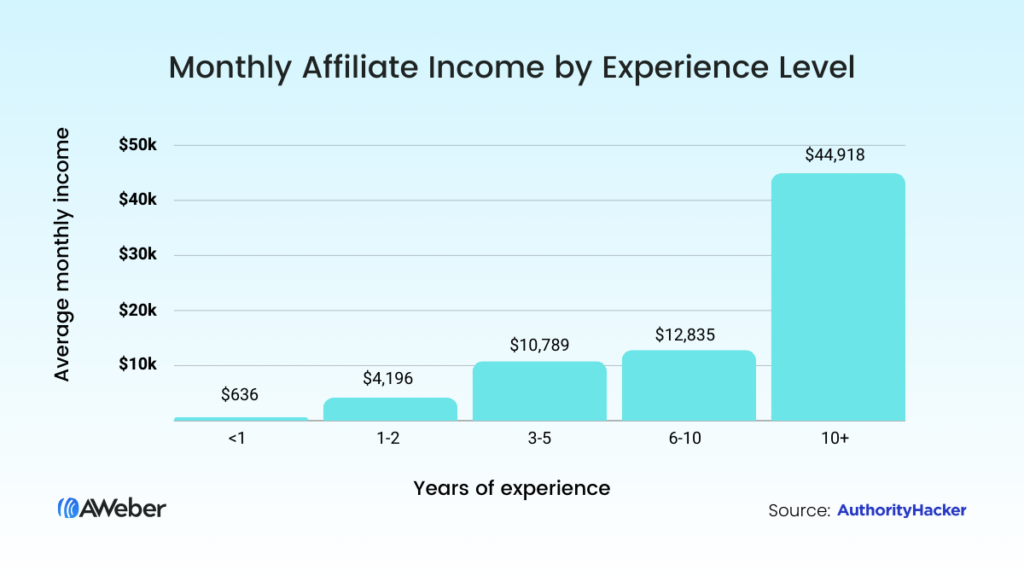
Meanwhile, if you’re in your first year of affiliate marketing, you can expect a slightly more humble return of $636 a month. Which probably won’t even cover your bills, let alone fast-track you toward a life of luxury.
Still, if you can get through those tricky first two years, the rewards are there for the taking.
And we can help you get there by sharing our top tips on how to be a successful affiliate marketer…
Where to post affiliate marketing links
Let’s start with the basics of how to promote an affiliate link. There are four main channels you can use, each with its own strengths and weaknesses:
SEO
Search engine optimization (SEO) involves building a search-friendly website that targets the types of keywords your audience is looking for. It’s the #1 source of traffic for affiliate marketers.
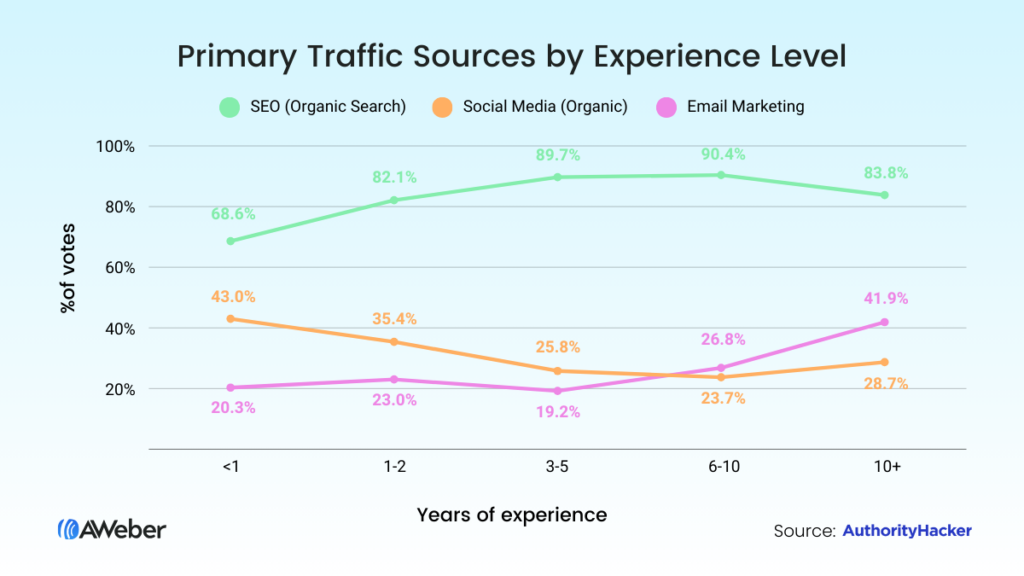
But SEO is tough. If you’re targeting a keyword with decent search volume, you’ll likely be competing with huge, generalist publishers like Forbes and Business Insider, so you’ve got your work cut out getting anywhere near the top #10 search results.
Organic search is also extremely volatile, with a 13-month study of 28,000+ domains finding that <5% of websites maintain their top #10 rankings for a whole year.
👍 SEO pros:
- Free traffic source
- Targets qualified shoppers searching for specific information
- Once you’ve built a well-optimized site, it can keep generating traffic for years
👎 SEO cons:
- Building an SEO-friendly site takes a lot of time
- However much work you put in, it’s extremely difficult to outrank massive publishers
- Search engine algorithms change regularly, so your rankings could tank overnight
Email marketing has the highest return on investment of any marketing channel, yet it’s something of an untapped resource — especially among new affiliates. In fact, experienced affiliate marketers use email marketing 47.8% more than beginners.
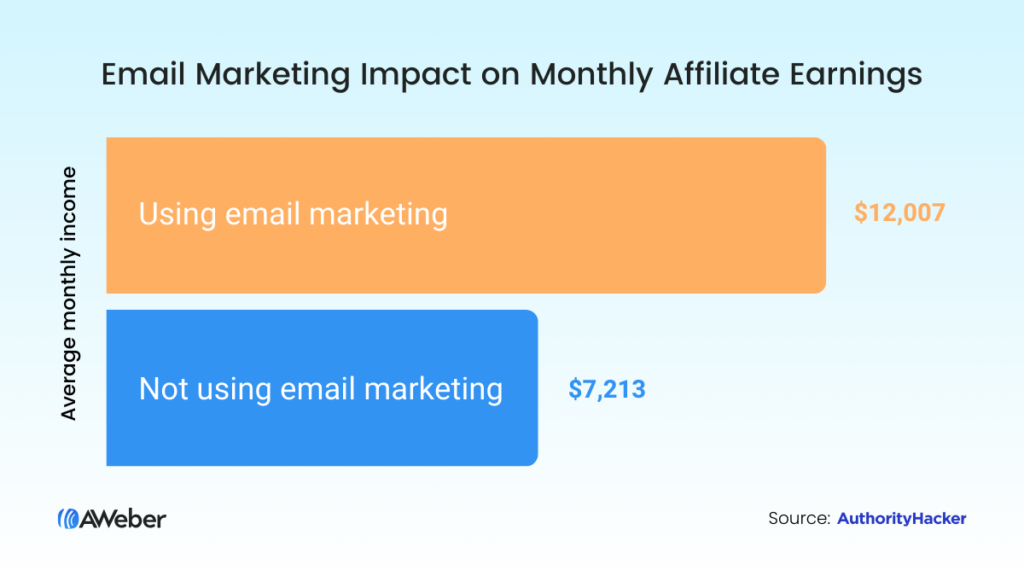
Not only are the expenses minimal (just the cost of your email marketing platform), but investing in email also reduces your reliance on search and social algorithms by letting you share affiliate links straight to your audience’s inbox.
👍 Email pros:
- Low costs
- Superb return on investment
- Reduces reliance on search and social algorithms
👎 Email cons:
- You’ll need some sort of external mechanism to grow your email list (like a landing page or website)
- It could take time to grow your email list
Paid media
Paid ads on search engines and social media mostly work on a pay-per-click (PPC) basis, which is exactly what it sounds like: you create an ad, set a budget, and only pay when someone clicks through to your landing page.
It’s a quick and convenient way to drive traffic to your affiliate site — you can build an ad campaign in a few minutes, then start generating clicks the moment you set it live. However, it’s not cheap, with an average cross-industry cost-per-click of $4.22 (and no guarantee that the clicker is going to buy anything).
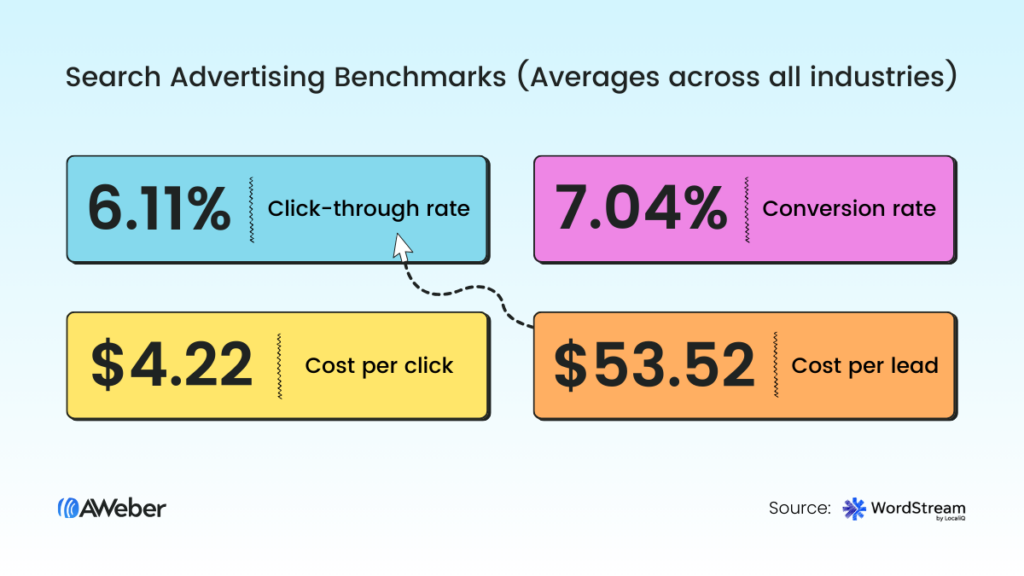
Given that you might only be making a few bucks in commission per sale, PPC just isn’t cost-effective in a lot of affiliate niches.
👍 PPC pros:
- Building ad campaigns is quick and easy
- Once a campaign goes live, you can start generating traffic instantly
👎 PPC cons:
- Costs-per-click are prohibitively high in some niches
- Once you stop paying, your traffic stops too
Organic social
Organic social media involves posting on platforms like Facebook, Instagram, and TikTok without any PPC ad budget. So it’s kind of like SEO: you’re relying on the quality of your content and your optimization efforts to reach your desired audience.
Unfortunately, organic reach on most social platforms has plummeted in recent years. To make matters worse, the likes of Facebook and TikTok want to keep you on their platform, not click through to an affiliate website (or your affiliate partner’s store) — so it’s becoming increasingly unreliable as a traffic source.
Which explains why affiliate marketing experts use organic social media 26.7% less than beginners.
👍 Organic social pros:
- Free source of traffic
👎 Organic social cons:
- Organic reach is declining on most social platforms
- Hard to turn social views into website traffic
The most effective strategy for affiliate marketing success
Most successful affiliate marketers use a combination of channels to reach their audience and drive traffic toward their affiliate partners’ websites.
It always pays to diversify. That way, your whole business model won’t be ruined by a single algorithm update. Also, the more your audience sees your content, the more likely they are to click through. Which, in turn, means they’ll see more of your affiliate links too.
So leveraging multiple channels is nothing new.
However, there’s one specific multichannel affiliate marketing strategy that’s surprisingly underused.
It works like this:
- Identify a specific pain point your audience wants to solve
- Build an online course to help answer that pain point
- Promote the online course (typically, the course is free, but some affiliates charge a small fee for their course content)
- Use the course to recommend specific online tools or products that will help resolve your audience’s pain point
- Whenever you promote a tool or product, add an affiliate link so you get paid when people click through and buy
This tactic is so effective because the people who sign up for your online course are looking for answers — and they trust you to provide them.
So when you recommend a product, they’ll sit up and take notice.
Let’s take a look at a real affiliate site that’s making bank through this technique…
CASE STUDY: Legendary Marketer
Legendary Marketer is a marketing education company that offers (paid) online courses on topics like selling digital products and building a coaching business.
But that’s not the only way Legendary Marketer makes money. It also employs the strategy we described in the previous section to generate a ton of affiliate commissions.
Despite the variety of courses it sells, Legendary Marketer’s homepage is geared toward promoting one specific product: its 15-Day Online Business Builder Challenge.
Just look at these two prominent CTAs:
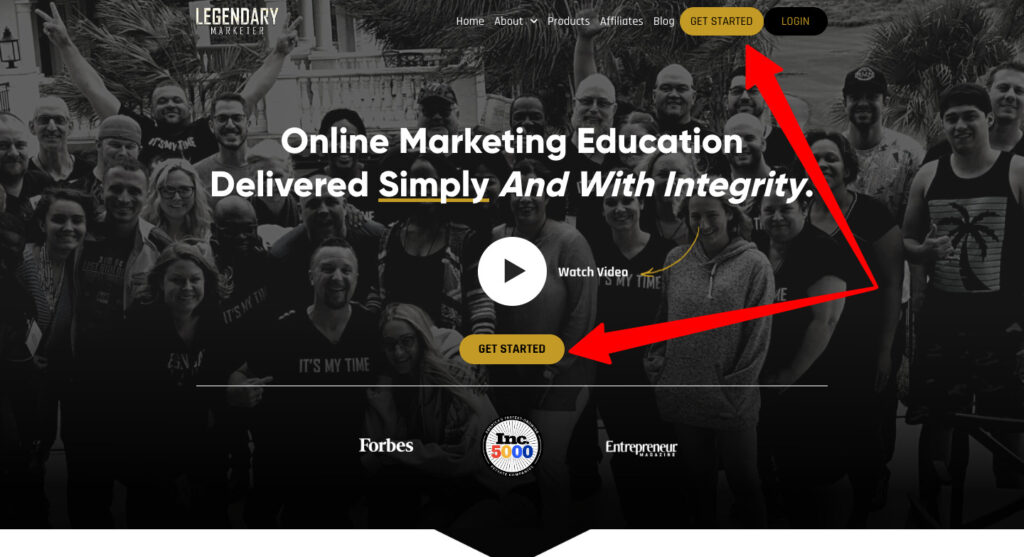
When you click through, you’re greeted with messaging that speaks to arguably the biggest pain point for anyone trying to build an online business: figuring out how to get started.
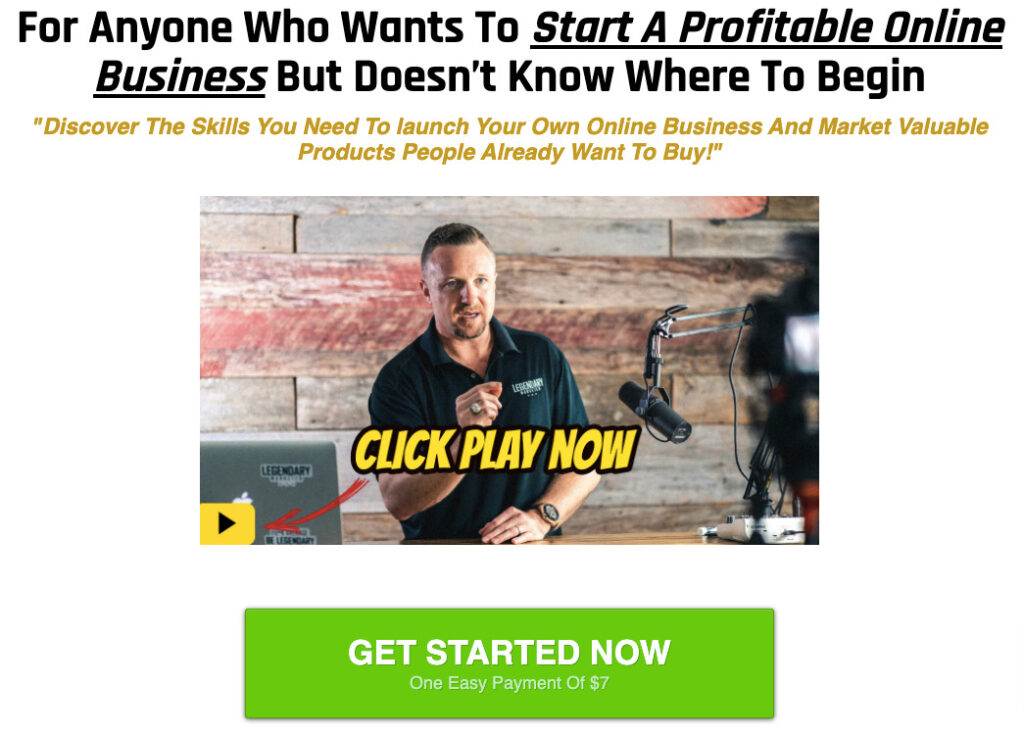
Legendary Marketer promises to help you overcome that challenge — and all for the low, low one-off price of $7.
In fact, the price tag is practically irrelevant. If you try to quit the page, you’ll be hit with an exit intent popup offering exactly the same course for just $1:

Why so cheap?
Because they don’t particularly care how much money they make from actually selling the course. Their real earner involves peppering their course content with product recommendations (and affiliate links) to generate clicks and commissions.
As an added bonus, enrolling in the course requires handing over your email address to Legendary Marketer — which means they can keep sharing recommendations straight to your inbox.
To be clear, none of this means the 15-Day Online Business Builder Challenge isn’t legit.
There’s nothing wrong with earning money from recommending high-quality products, just so long as you’re upfront and honest about it.
Other affiliate marketing course ideas
I think we can all agree that Legendary Marketer has hit on a highly effective affiliate marketing strategy.
But we’re not necessarily suggesting you do exactly the same thing. After all, there are plenty of other niches to target and pain points to solve. For instance:
Pain point: Get your first 500 email subscribers
This is a classic concern for new affiliate marketers (and, indeed, for any business owner or content creator who wants to leverage the benefits of email marketing), which makes it a fantastic fit for an online course.
Before you start creating the course content, you’d seek out a bunch of affiliate programs for tools to help people build their email list. We’re thinking:
- A graphic design tool like Canva for designing and creating a lead magnet
- A landing page builder like AWeber to create a lead capture landing page
- An email marketing platform to set up automated campaigns (again, they can do this through AWeber)
Pain point: Earn six figures on Etsy
Another common pain point — because every Etsy merchant wants to make more money.
You’d follow the same process when building this online course: consider all the tools Etsy sellers might need to grow their revenue, then sign up for the relevant affiliate programs and add their links to your course content. Tools like:
- PickFu for optimizing product images, descriptions, videos, ads, and product pricing
- Vela for managing Etsy product listings
- Outfy for automated social media management for online stores
- LeadDyno for promoting an Etsy store through affiliate marketing
And, of course, AWeber for building an email list and running newsletter campaigns to drive traffic to an Etsy store.
Pain point: Make your first dropshipping sale
Like affiliate marketing, dropshipping is a popular side hustle, helping people build a revenue stream without dealing with many of the biggest challenges of running a “proper” e-commerce business, like:
- Spending a ton of cash upfront on products
- Managing store inventory
- Dealing with product shipping
So it’s not hard to see the appeal of launching a dropshipping store. But, just like with any online business, most wannabe dropshippers don’t know where to begin — making this a perfect online course niche.
Again, there’s no shortage of products (with affiliate programs) you can promote, including:
- E-commerce platforms like Shopify
- SEO tools like Semrush
- Product-sourcing tools like Dropship
- E-commerce social media management tools like Outfy
- Shopify theme vendors like ThemeForest
Plus they’ll need an email marketing tool, which is where AWeber comes in.
4 affiliate marketing best practices to drive more clicks and sales
Building a successful affiliate marketing business isn’t just about having the right strategy. You also need to execute it effectively. Make it happen by following these best practices:
Choose a diverse range of affiliate partners
Your affiliate partners — also known as advertisers — are the people who pay you for promoting their products. So it’s fair to say they’ll play an integral role on your journey to affiliate marketing success.
Naturally, affiliate advertisers want to build robust, mutually beneficial relationships with their best affiliates.
But it’s important to remember that they’re businesses, not charities, so they might be compelled to change their terms and conditions at a moment’s notice. For instance, Amazon — one of the world’s biggest affiliate advertisers — famously slashed commissions across multiple categories back in 2020, putting a major dent in many affiliate marketers’ earnings.
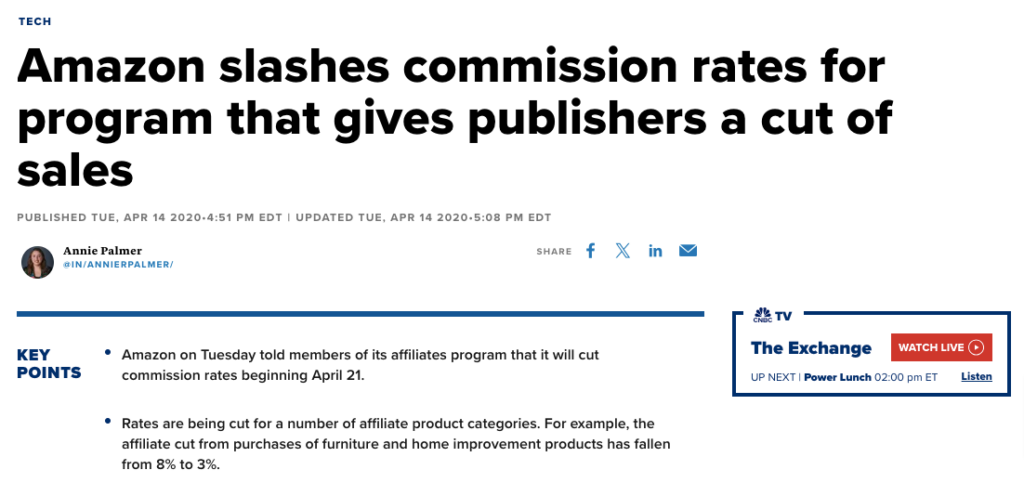
If you put all your eggs in the metaphorical basket of a single affiliate program, a similar decision from your affiliate partner could decimate your business.
So it definitely pays to spread the risk around by promoting multiple affiliate programs (e.g. other markets like eBay and Etsy are a good substitute for Amazon).
Promote quality affiliate products
When you’re looking for affiliate partners, it’s easy to be blinded by attractive commission rates.
But the reality is that the highest-paying products aren’t necessarily the best for your audience. Sadly, the exact opposite is often true: they’re only paying big commissions because otherwise no one would recommend them.
While it’s tempting to focus on making as much money as possible in the short term, your affiliate business will be a whole lot more sustainable if you exclusively promote high-quality products. So take the time to check out customer reviews before signing up — and, ideally, recommend products that you actually use.
Build an asset, not a social channel
Sure, there are real affiliate marketers making big money from their followings on platforms like TikTok and YouTube.
But there’s a problem: those folks don’t actually own their audience. TikTok and YouTube do.
You might be thinking: “So what? I don’t care if TikTok holds all the cards as long as I’m still making money.” However, there are some major downsides to this approach.
For starters, tastes in social media change fast. If people suddenly lose interest in your chosen social platform, BAM, there goes your audience — and there’s no guarantee they’ll follow you to a different platform.
It also leaves you overly reliant on social algorithms. If TikTok or YouTube decide they don’t want people to see your content anymore, you’re dead in the water.
That’s why we believe the best route to becoming a successful affiliate marketer is to build your own website. Or, at the very least, a landing page you can use to capture email addresses.
Target high-intent keywords
Earlier in this article, we pointed out that SEO is the top traffic source for affiliate websites.
But not all search traffic is equally valuable.
It’s fine to have one or two pieces of content dedicated to top-of-the-funnel topics (like how to start an online business). But the bulk of your SEO-focused articles or videos should target commercially focused keywords.
Typically, commercial keywords look like this:
| Commercial keyword type | Example |
| Best {product type} | Best dog food |
| Best {product type} for {pain point} | Best dog food for sensitive stomachs |
| {Product X} vs {Product Y} | Harringtons vs Wainwrights puppy food |
People searching for these sorts of terms are close to making a buying decision. So if they find (and enjoy) your content, there’s a good chance they’ll click through to your affiliate partner’s site and make a purchase.
Supercharge your affiliate marketing success with AWeber
Building a successful affiliate marketing business is hard work. And there are no guarantees — otherwise, every affiliate marketer would be a millionaire.
But we can guarantee that you’ll stand a much better chance if you build an email list, then target your subscribers with regular newsletters recommending all your favorite products.
That’s why you need AWeber.
Our drag-and-drop builder and AI writing assistant make it quick and easy to create beautiful, engaging, high-converting marketing emails, while our landing page builder and signup forms give you all the tools to grow your list.
Sign up for your free AWeber account today.
And, once you’ve done it, why not join our affiliate program and spread the love?
 87% off ends soon!
87% off ends soon! 
